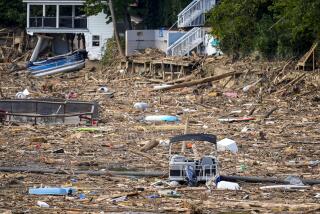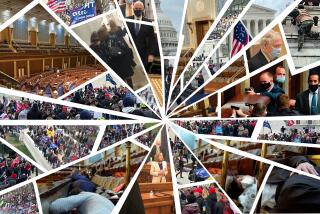Chance to Renew Ties for Clinton
- Share via
LITTLE ROCK, Ark. — On Sunday, while Monica S. Lewinsky met in Washington with the House members prosecuting President Clinton in the Senate, the president was in the small Arkansas town of Beebe. And so was Paula Corbin Jones.
He had flown to Little Rock and then to Beebe to examine damage caused by deadly tornadoes that hit Thursday. She had traveled to the small town northeast of Little Rock to visit friends last week, stayed on after the tornadoes struck, and when the president came to town, she joined the crowd.
It was her allegation of sexual harassment that unleashed a string of events that led to the revelation of the president’s affair with Lewinsky, which in turn brought him to his current predicament, impeached by the House and on trial in the Senate on charges of perjury and obstruction of justice.
Awkward, yes, she said of her presence. But she came to hear about what the government intended to do for the community.
“I want to see what they’re doing to help,” she said.
Jones listened to Clinton’s speech. Then, as he began shaking hands, she turned away.
Clinton--by one description stunned, by another amazed--seemed to ignore a reporter’s question about Jones’ presence. He paused about 10 seconds, then asked, “What did he say?” He rolled his eyes. He let out a laugh. And he resumed his rope-line work.
Throughout the day, Clinton encountered the people and places of his past.
In Beebe, there was Kelton Keatley, whom the president described as an old friend whose political support dated to his first gubernatorial race 20 years back.
True, said Keatley, but he told a reporter later that there was more to the story.
“I helped him win his first race for governor, helped beat him the second race, and helped elect him every race since,” Keatley said, explaining that he had opposed Clinton when he first ran for reelection because “he was young and didn’t want to listen.”
Keatley’s home of 32 years was a brick structure with white columns out front. On Sunday, all that remained was a platform where the house once stood.
He said he asked of Clinton one favor: Rebuild the junior high school. Aluminum siding from the school, a quarter-mile away, came to rest around the branches of an uprooted poplar tree in Keatley’s yard. Keatley said the president pledged that the rebuilding would be done.
The tornadoes killed seven people in Little Rock and Beebe.
In Little Rock, he attended services at Immanuel Baptist Church, where he had worshiped as governor, toured the rubble-strewn streets near the governor’s mansion where he had jogged years ago, and walked through another damaged neighborhood of bungalows.
Clinton reached out at every turn, throwing a hug here, an arm around a shoulder there, offering for all a wave, a handshake, one word or many more of encouragement as he turned loquacious among the home folk. For all the scenes of disaster he has visited, as governor and president over 18 of the last 20 years, none had struck as close to home as this, he said.
“It’s a . . . it’s very difficult to see,” he said, reaching for words that momentarily failed him in the midst of the Quapaw Quarter--a community of “resilient, innovative” people, he said, and “one of the most unusual places I’ve ever lived.”
It was here, amid the 80-to-100-year-old two- and three-story homes of brick and stucco, that he and Hillary Rodham Clinton had been members of a baby-sitting cooperative, where the future first lady and their daughter, Chelsea, visited with neighbors on the rare days when snow closed the local schools. Throughout the day, he offered reminiscences of life in the neighborhood that is now a historic preservation district.
He was less talkative about the subject of impeachment.
To a reporter’s question about this week’s vote in the Senate on whether to dismiss the case, he replied: “I’m not sure what they’re going to do. I’m not going to talk about it.”
Then, he turned quickly away to continue his walk, at times accompanied closely by James Lee Witt, director of the Federal Emergency Management Administration, and Transportation Secretary Rodney Slater, both Arkansans.
At every quarter, Clinton saw the random devastation typical of tornadoes. He walked past one home where a front wall had been peeled away, revealing a bookshelf still holding neatly arrayed volumes of an encyclopedia.
At the Harvest Foods grocery story, its roof and walls were collapsed, but the candy displays were untouched. Its checkout counters were rearranged, but the paper bags were still in neat stacks.
Robert E. Howard, the store’s 66-year-old pharmacist, was killed when the building collapsed.
“This is a landmark for me, this store here,” Clinton said. “Hillary and Chelsea and I used to come down here. We think of the fine pharmacist here who lost his life.”
Clinton had zigzagged from curb to curb, covering perhaps a dozen blocks as he greeted Quapaw residents, who halted their initial repair work. He told a crowd of a few hundred gathered in a parking lot: “I thought about how many hundreds of times I had run on those streets. And all these folks kept coming out and said, ‘The last time I saw you, you were running by here. And I had a roof on my house.’ ”
Throughout the day, Clinton held to a determined but unhurried pace, speaking quietly with small groups of people.
At one point, a man called out to Clinton from a distance: “We love you!”
The president, suddenly of full voice, shouted back: “Thank you!”
More to Read
Sign up for Essential California
The most important California stories and recommendations in your inbox every morning.
You may occasionally receive promotional content from the Los Angeles Times.













